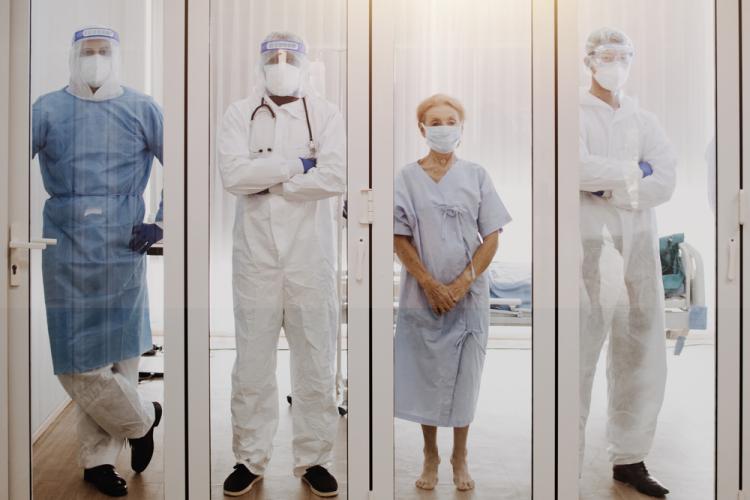Multiple studies from the CARE project teach us more about how COVID19 wreaks havoc, and how it might be defeated

CARE, an IMI-funded project launched in the wake of the COVID19 pandemic outbreak, is the largest undertaking of its kind dedicated to accelerating the discovery and development of urgently-needed treatment options for COVID19 patients. It focusses both on identifying therapeutics for the current pandemic as well as long-term preparedness by identifying antiviral therapies for future outbreaks. The project has published a number of scientific papers with valuable findings that are having an impact on patient treatment. Here is a summary of some of their findings.
A controversial therapeutic fails to deliver
CARE demonstrated that the controversial antimalarial drug Hydroxychloroquine didn’t show any significant effect on viral load in non-human primates, whether alone or in combination with azithromycin. This provided solid scientific evidence on the use of the drug for the treatment of COVID19 patients. See the paper in Nature: Hydroxychloroquine use against SARS-CoV-2 infection in non-human primates
Genetic link to severe disease likelihood
In another study, they showed that the activation of a type of white blood cells called neutrophils could be linked to the overexpression of a protein encoded by the CD177 gene, and therefore a hallmark of COVID19 severe disease. The study involved taking blood samples from infected people (and healthy controls). They performed cell phenotypic, serum and RNA-seq gene expression analyses. The results showed abnormalities in 27 cell populations and an elevation of 42 cytokines, neutrophil chemo-attractants, and inflammatory components in patients. Analyses revealed a high abundance of CD177, a specific neutrophil activation marker, contributing to the clustering of severe patients. They concluded that CD177 is a risk factor for more severe disease. This can help spot these riskier cases when people are admitted to hospitals. See the paper in in Cell: CD177, a specific marker of neutrophil activation, is a hallmark of COVID-19 severity and death
We now know more about what’s going on in the endothelial cells
Over the course of the pandemic it has been recognised that many people who die from COVID19 have circulation problems (i.e. thrombosis), meaning they don’t necessarily succumb due to a problem in their lungs. The CARE researchers wanted to know if the virus was infecting and damaging the endothelial cells – the cells that line the blood vessels, lymph nodes and the heart – directly, or if the virus was damaging these cells in another indirect way i.e. via circulating molecules produced in other sites of the body.
They confirmed that the viral infection occurred in neighbouring cells and organs and that endothelial cells were damaged indirectly by a series of molecules (e.g. immune cells, platelets and complement activation, circulating pro-inflammatory cytokines) released in the circulatory system by those cells. This revelation is important because in order to protect people from heart problems associated with COVID19, doctors need to know exactly what mechanism the virus is using to make people severely ill. See the paper in Circulation: Lack of Evidence of Angiotensin-Converting Enzyme 2 Expression and Replicative Infection by SARS-CoV-2 in Human Endothelial Cells.
New assay for understanding antibody response in natural infection versus vaccination
CARE produced a new assay (a test used for analysis) that can help assess the neutralising activity of antibodies that are induced after natural infection against different SARS-CoV-2 spike protein variants of concern. This assay can also be used to help understand and characterise vaccine-induced antibody responses, and to assess the potency of monoclonal antibodies. See the paper in Science Translational Medicine: A high-throughput cell- and virus-free assay shows reduced neutralization of SARS-CoV-2 variants by COVID-19 convalescent plasma
Insights into the durability of different antibodies against spike
People who have been infected with COVID19 make different types of antibodies against the virus. A study by CARE suggested that, in order to avoid undercounting the levels of antibody-induced immunity in the population, it is better to test for a specific type of antibody response i.e. the antibodies that are generated in response to what’s called the trimetric spike protein, as opposed to the monomeric spike protein or the nucleocapsid (N) proteins.
In the early days of the pandemic, laboratories tested for monomeric spike protein, whose levels wane quickly after infection, thus leading the researchers to believe that cases were underestimated. This work is extremely important because it is making sure that the real number of antibodies in the population can be counted. See the paper in the Journal of Virology: Changes in SARS-CoV-2 Spike versus Nucleoprotein Antibody Responses Impact the Estimates of Infections in Population-Based Seroprevalence Studies
Accelerated discovery of antiviral molecules to tackle COVID19
The CARE team have produced other important outcomes that have yet to be published but that are already having an impact on the development of therapeutics for the management of COVID19 patients and future coronavirus outbreaks. These developments include a candidate prophylactic anti-SARS-CoV-2 neutralising antibody to fight current circulating variants of concern. This antibody is ongoing evaluation in in vivo models for efficacy.
They have also identified potentially useful small molecules that will now need to go through lengthy testing, developed a series of tools (cell lines, animal models, computer models, libraries of expression vectors, a genomics platform…) that are being used to study the antiviral properties of different compounds, and carried out preclinical research. The team are also setting up a clinical trial network for future phase one and phase two studies.
